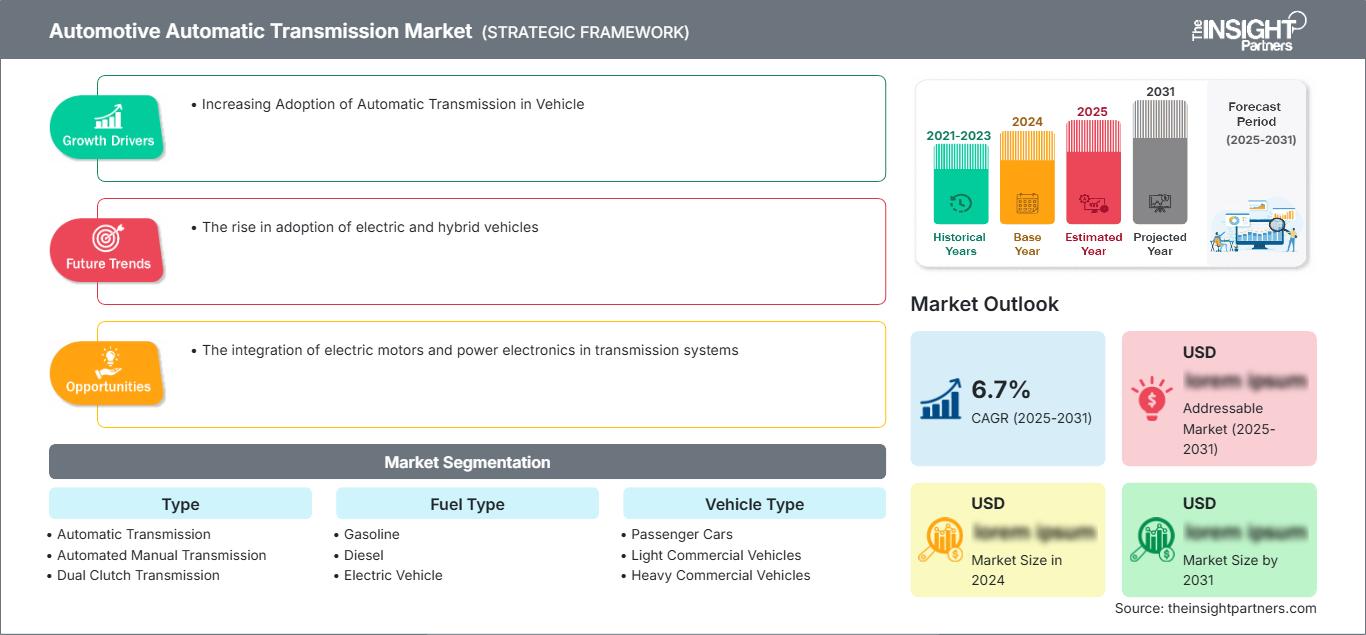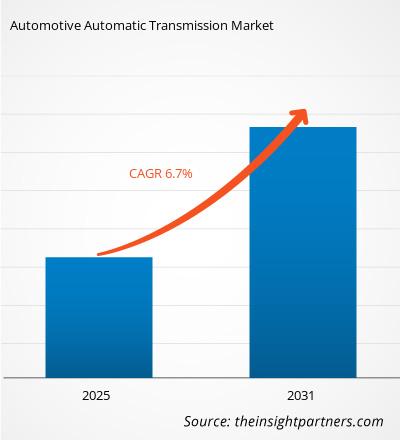Der Markt für automatische Getriebe für Kraftfahrzeuge wird zwischen 2023 und 2031 voraussichtlich eine durchschnittliche jährliche Wachstumsrate (CAGR) von 6,7 % verzeichnen. Die zunehmende Verbreitung von Elektro- und Hybridfahrzeugen dürfte ein wichtiger Markttrend bleiben.
Marktanalyse für automatische Getriebe für Kraftfahrzeuge
- Das Wachstum automatischer Getriebesysteme geht auch mit einer steigenden Nachfrage nach Elektro- und Hybridfahrzeugen einher, die nur mit Hilfe spezieller Getriebesysteme funktionieren. Darüber hinaus hat die schnelle Verbreitung adaptiver und automatischer Getriebesteuerungen zur Entwicklung automatischer manueller Getriebe geführt.
- Da fortschrittliche automatische Getriebesysteme zunehmend an Vertrauen gewinnen, bevorzugen Hersteller sie zunehmend gegenüber herkömmlichen manuellen Systemen, da sie sich als umweltfreundlich erweisen und ein reibungsloses Fahrerlebnis ermöglichen.
Marktübersicht für automatische Getriebe für Kraftfahrzeuge
- Das Wachstum des Marktes ist auf die Entwicklung fortschrittlicher manueller Getriebe mit automatischem Schaltmodus und adaptiver Getriebesteuerung zurückzuführen, was den Trend zu hochentwickelten Getriebetechnologien anzeigt. Ein weiterer Trend, der den Markt antreibt, ist die steigende Nachfrage nach Elektro- und Hybridfahrzeugen, die fortschrittliche Getriebesysteme erfordern.
- Getriebesysteme verfügen über Elektromotoren und Leistungselektronik, die in der kohlenstoffarmen Technologie stark nachgefragt sind. Dies wird durch den Übergang zu hocheffizienten Elektrofahrzeugen erleichtert. Die Integration von Elektromotoren und Leistungselektronik in Automatikgetriebesysteme wird voraussichtlich den globalen Markt für Automatikgetriebe in der Automobilindustrie in Zukunft antreiben.
Passen Sie diesen Bericht Ihren Anforderungen an
Sie erhalten kostenlos Anpassungen an jedem Bericht, einschließlich Teilen dieses Berichts oder einer Analyse auf Länderebene, eines Excel-Datenpakets sowie tolle Angebote und Rabatte für Start-ups und Universitäten.
Markt für automatische Getriebe für Kraftfahrzeuge: Strategische Einblicke

- Holen Sie sich die wichtigsten Markttrends aus diesem Bericht.Dieses KOSTENLOSE Beispiel umfasst Datenanalysen, die von Markttrends bis hin zu Schätzungen und Prognosen reichen.
Sie erhalten kostenlos Anpassungen an jedem Bericht, einschließlich Teilen dieses Berichts oder einer Analyse auf Länderebene, eines Excel-Datenpakets sowie tolle Angebote und Rabatte für Start-ups und Universitäten.
Markt für automatische Getriebe für Kraftfahrzeuge: Strategische Einblicke

- Holen Sie sich die wichtigsten Markttrends aus diesem Bericht.Dieses KOSTENLOSE Beispiel umfasst Datenanalysen, die von Markttrends bis hin zu Schätzungen und Prognosen reichen.
Markttreiber und -chancen für Automatikgetriebe
Zunehmende Verbreitung von Automatikgetrieben in Fahrzeugen begünstigt den Markt
- Die zunehmende Anzahl von Fahrzeugen mit Automatikgetrieben ist einer der wichtigsten Antriebsfaktoren für den Markt für Automatikgetriebe in Fahrzeugen. Zu den Faktoren gehören die zunehmende Verwendung von automatischen Schaltgetrieben mit adaptiver Getriebesteuerung und der zunehmende Trend zu Elektro- und Hybridfahrzeugen. Auch das Ziel beider Automobilhersteller, Innovation und Effizienz zu maximieren, um dieser Umweltherausforderung zu begegnen, führt zu Wachstum in der Branche der Automatikgetriebe in Fahrzeugen.
- Gesetzliche Vorschriften zur Reduzierung des Kohlendioxidausstoßes und zur Verbesserung der Kraftstoffeffizienz zwingen die Fahrzeughersteller jedoch dazu, die neuesten Getriebesysteme zu verwenden, was zu einem Marktwachstum führt.
Die Integration von Elektromotoren und Leistungselektronik in Getriebesysteme
- Die Integration von Elektromotoren und Leistungselektronik in Automatikgetriebe in Fahrzeugen ist verständlicherweise ein bedeutsamer Sprung auf dem Markt für Automatikgetriebe in Fahrzeugen. Diese Integration geht einher mit der jüngsten Verschärfung der weltweiten Emissionsvorschriften und den Erwartungen der Fahrzeugnutzer nach einem möglichst geringen Kraftstoffverbrauch. Daher spielt die Elektrifizierung des Fahrzeuggetriebes eine zentrale Rolle in der zukünftigen Fahrzeuggetriebetechnologie, vor allem bei Elektro- und Hybridfahrzeugen.
- Die Integration von Elektromotor und Leistungselektronik in das Fahrzeug-Automatikgetriebe ist ein wichtiger Faktor für das bevorstehende starke Wachstum des Marktes für Fahrzeug-Automatikgetriebe. Durch diese Integration werden die Leistung des Fahrzeugs, die Reduzierung des Schadstoffausstoßes und der Kraftstoffverbrauch verbessert.
Segmentierungsanalyse des Marktberichts für Kfz-Automatikgetriebe
Schlüsselsegmente, die zur Ableitung der Marktanalyse für Kfz-Automatikgetriebe beigetragen haben, sind Typ, Kraftstoffart und Fahrzeugtyp.
- Basierend auf dem Typ ist der Markt für Kfz-Automatikgetriebe in Automatikgetriebe, automatisiertes Schaltgetriebe, Doppelkupplungsgetriebe und stufenloses Getriebe unterteilt.
- Auf der Grundlage der Kraftstoffart ist der Markt in Benzin, Diesel, Elektrofahrzeuge und Hybrid unterteilt.
- Basierend auf dem Fahrzeugtyp ist der Markt für Kfz-Automatikgetriebe in Personenkraftwagen, leichte Nutzfahrzeuge und schwere Nutzfahrzeuge unterteilt.
Marktanteilsanalyse für Kfz-Automatikgetriebe nach Geografie
- Der Marktbericht für Kfz-Automatikgetriebe umfasst eine detaillierte Analyse von fünf großen geografischen Regionen, die die aktuelle und historische Marktgröße sowie Prognosen für 2021 bis 2031 umfasst und Nordamerika, Europa, den asiatisch-pazifischen Raum (APAC), den Nahen Osten und Afrika (MEA) sowie Süd- und Mittelamerika.
- Jede Region ist weiter in entsprechende Länder unterteilt. Dieser Bericht bietet Analysen und Prognosen für mehr als 18 Länder und deckt die Marktdynamik für Kfz-Automatikgetriebe ab, wie z. B. Treiber, Trends und Chancen, die die Märkte auf regionaler Ebene beeinflussen.
- Darüber hinaus umfasst der Bericht eine PEST-Analyse, die die Untersuchung der wichtigsten Faktoren umfasst, die den Markt für Kfz-Automatikgetriebe in diesen Regionen beeinflussen.
Markt für automatische Getriebe für Kraftfahrzeuge
Die Analysten von The Insight Partners haben die regionalen Trends und Faktoren, die den Markt für Kfz-Automatikgetriebe im Prognosezeitraum beeinflussen, ausführlich erläutert. In diesem Abschnitt werden auch die Marktsegmente und die geografische Lage von Kfz-Automatikgetrieben in Nordamerika, Europa, im asiatisch-pazifischen Raum, im Nahen Osten und Afrika sowie in Süd- und Mittelamerika erläutert.Umfang des Marktberichts für automatische Getriebe in Kraftfahrzeugen
| Berichtsattribut | Einzelheiten |
|---|---|
| Marktgröße in 2024 | US$ XX million |
| Marktgröße nach 2031 | US$ XX Million |
| Globale CAGR (2025 - 2031) | 6.7% |
| Historische Daten | 2021-2023 |
| Prognosezeitraum | 2025-2031 |
| Abgedeckte Segmente |
By Typ
|
| Abgedeckte Regionen und Länder | Nordamerika
|
| Marktführer und wichtige Unternehmensprofile |
|
Dichte der Marktteilnehmer für Automatikgetriebe im Automobilbereich: Verständnis ihrer Auswirkungen auf die Geschäftsdynamik
Der Markt für Automatikgetriebe für Kraftfahrzeuge wächst rasant. Dies wird durch die steigende Endverbrauchernachfrage aufgrund veränderter Verbraucherpräferenzen, technologischer Fortschritte und eines stärkeren Bewusstseins für die Produktvorteile vorangetrieben. Mit der steigenden Nachfrage erweitern Unternehmen ihr Angebot, entwickeln Innovationen, um den Bedürfnissen der Verbraucher gerecht zu werden, und nutzen neue Trends, was das Marktwachstum weiter ankurbelt.

- Holen Sie sich die Markt für automatische Getriebe für Kraftfahrzeuge Übersicht der wichtigsten Akteure
Neuigkeiten und aktuelle Entwicklungen zum Markt für Automatikgetriebe für Kraftfahrzeuge
Der Markt für Automatikgetriebe für Kraftfahrzeuge wird durch die Erhebung qualitativer und quantitativer Daten aus Primär- und Sekundärforschung bewertet, die wichtige Unternehmensveröffentlichungen, Verbandsdaten und Datenbanken umfasst. Im Folgenden sind einige der Entwicklungen auf dem Markt für Automatikgetriebe für Kraftfahrzeuge aufgeführt:
- ZF PowerLine markiert den Beginn einer kleinen Revolution im Segment der mittelschweren Lkw, Pickups und Busse: Mit acht Gängen und einem von weltweit führenden Pkw-Systemen übernommenen Konstruktionsprinzip übertrifft das neue Automatikgetriebe die derzeit verfügbaren Systeme. (Quelle: ZF Friedrichshafen AG, Unternehmenswebsite, Dezember 2019)
- Ford hat mit der Produktion eines neuen 10-Gang-Automatikgetriebes für Transit-Modelle mit Hinterradantrieb (RWD) begonnen, das sich durch exzellente Kraftstoffeffizienz, 1 herausragende Haltbarkeit und eine Anhängelast von bis zu 2.800 kg2 auszeichnet. (Quelle: The Ford Motor Company, Unternehmenswebsite, Juni 2021)
Bericht zum Markt für automatische Getriebe in Kraftfahrzeugen – Abdeckung und Ergebnisse
Der „Marktgröße und -prognose für automatische Getriebe in Kraftfahrzeugen (2021–2031)“ Der Bericht bietet eine detaillierte Analyse des Marktes und deckt die folgenden Bereiche ab:
- Marktgröße und Prognose für Kfz-Automatikgetriebe auf globaler, regionaler und Länderebene für alle abgedeckten wichtigen Marktsegmente
- Markttrends und Marktdynamiken für Kfz-Automatikgetriebe wie Treiber, Einschränkungen und wichtige Chancen
- Detaillierte PEST/Porters Five Forces- und SWOT-Analyse
- Marktanalyse für Kfz-Automatikgetriebe mit wichtigen Markttrends, globalen und regionalen Rahmenbedingungen, wichtigen Akteuren, Vorschriften und aktuellen Marktentwicklungen
- Branchenlandschaft und Wettbewerbsanalyse mit Marktkonzentration, Heatmap-Analyse, prominenten Akteuren und aktuellen Entwicklungen für den Markt für Kfz-Automatikgetriebe
- Detaillierte Unternehmensprofile
- Historische Analyse (2 Jahre), Basisjahr, Prognose (7 Jahre) mit CAGR
- PEST- und SWOT-Analyse
- Marktgröße Wert/Volumen – Global, Regional, Land
- Branchen- und Wettbewerbslandschaft
- Excel-Datensatz
Aktuelle Berichte
Erfahrungsberichte
Grund zum Kauf
- Fundierte Entscheidungsfindung
- Marktdynamik verstehen
- Wettbewerbsanalyse
- Kundeneinblicke
- Marktprognosen
- Risikominimierung
- Strategische Planung
- Investitionsbegründung
- Identifizierung neuer Märkte
- Verbesserung von Marketingstrategien
- Steigerung der Betriebseffizienz
- Anpassung an regulatorische Trends




















 Kostenlose Probe anfordern für - Markt für automatische Getriebe für Kraftfahrzeuge
Kostenlose Probe anfordern für - Markt für automatische Getriebe für Kraftfahrzeuge